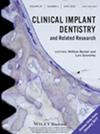Maintenance Costs, Time, and Efforts Following Implant Therapy With Fixed Restorations Over an Observation Period of 10 Years: A Randomized Controlled Clinical Trial
Abstract
Objectives
To assess the costs and efforts of maintenance therapy following implant treatment with fixed restoration over an observation period of 10 years.
Material and Methods
This randomized controlled clinical trial included 64 patients who were randomly assigned to receive one of two implant systems (AST or STM) and fixed restoration. Patients were included in a regular maintenance program and were examined at loading, 1, 3, 5, 8, and 10 years. Outcome measures included technical and biological complications, time, efforts, and costs to resolve them.
Results
A total of 97 implants were placed in 64 patients (AST: 54, STM: 43). Patient recall rates at 5 and 10 years were 89% and 67%. In general, technical complications were resolved within one to two appointments (mean = 1.5), and biological complications required a mean of 1.3 appointments. The overall regular maintenance time for the period of 10 years amounted to 77 min per year. Technical complications occurred in 39.5% of the patients, with screw-loosening being the most common one (43.4% of all complications). The most time-consuming technical complication was abutment fracture (94 min ± 68), followed by screw fracture (84 min ± 38). The prevalence of peri-implant mucositis on the patient level was 30.2%, and it was 9.3% for peri-implantitis. The average annual maintenance costs amounted to 9% of the initial cost of the implant treatment over the period of 10 years.
Conclusions
Additional regular maintenance costs and costs due to the treatment of potential complications have to be taken into consideration when placing dental implants. The majority of technical complications could be resolved within one appointment, whereas the time needed to treat biological complications varied between one and three appointments for peri-implantitis.


 求助内容:
求助内容: 应助结果提醒方式:
应助结果提醒方式:


